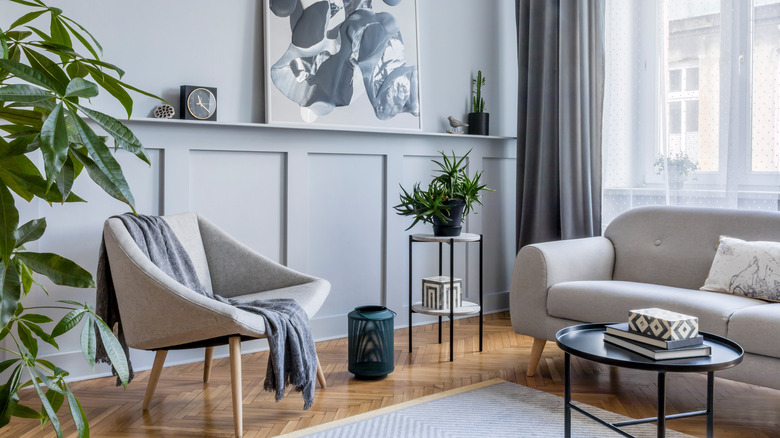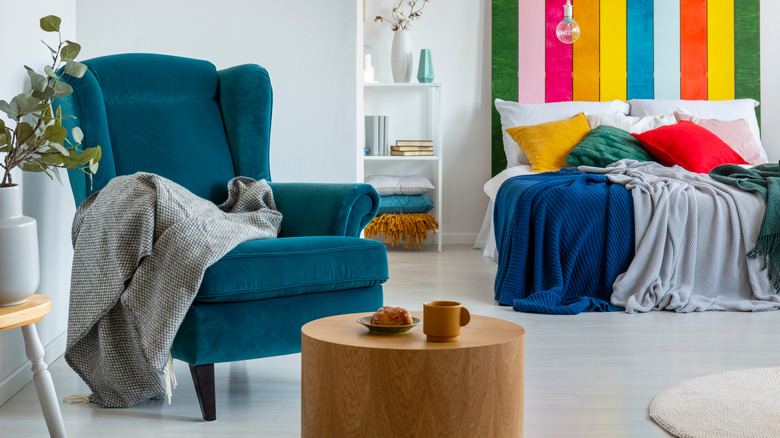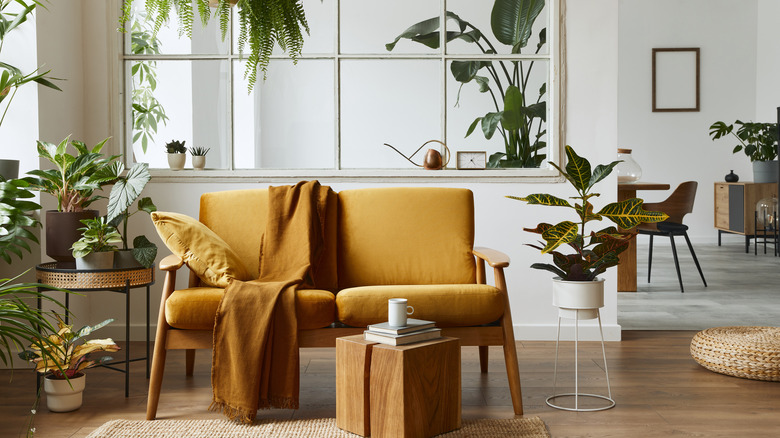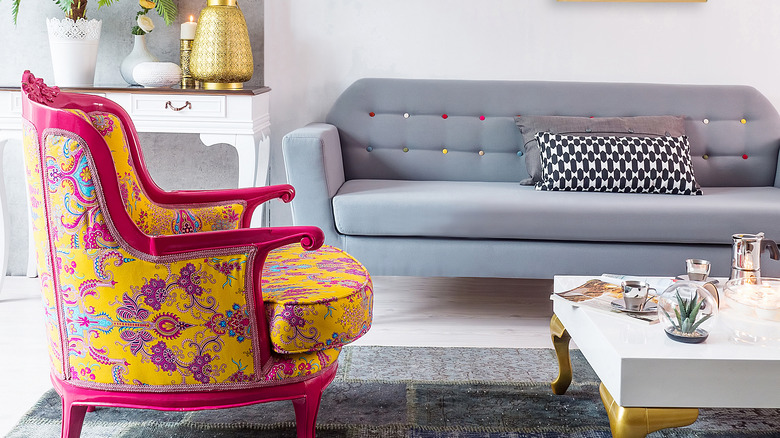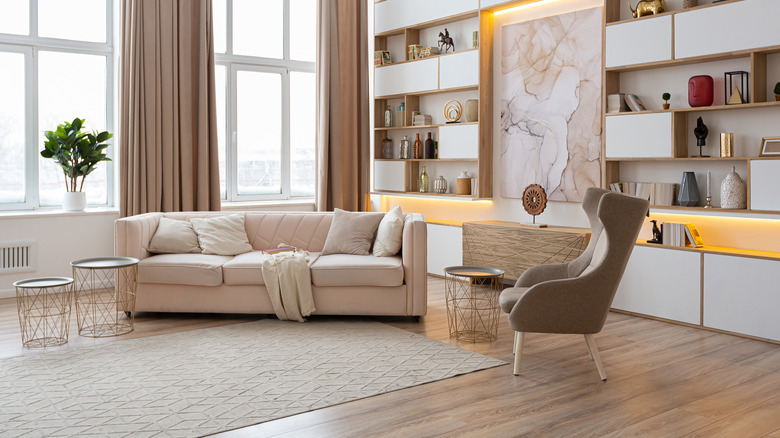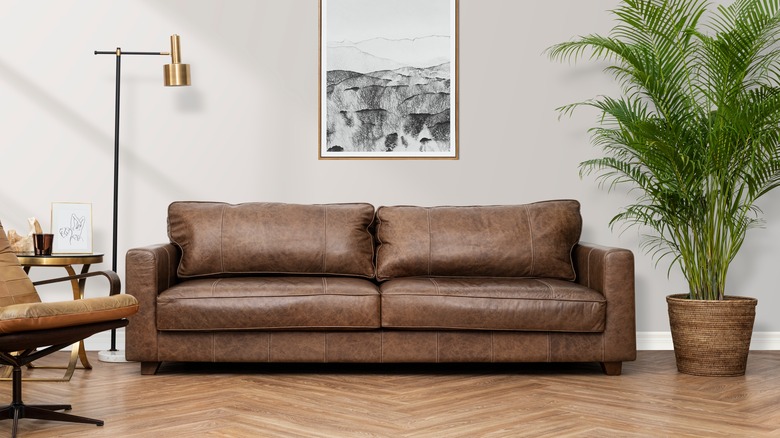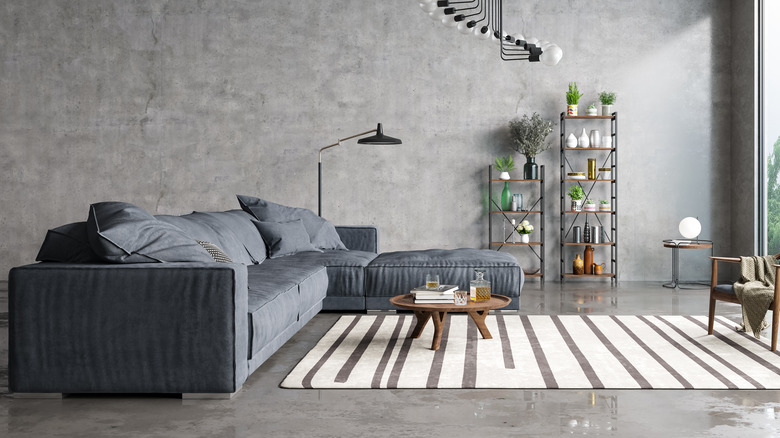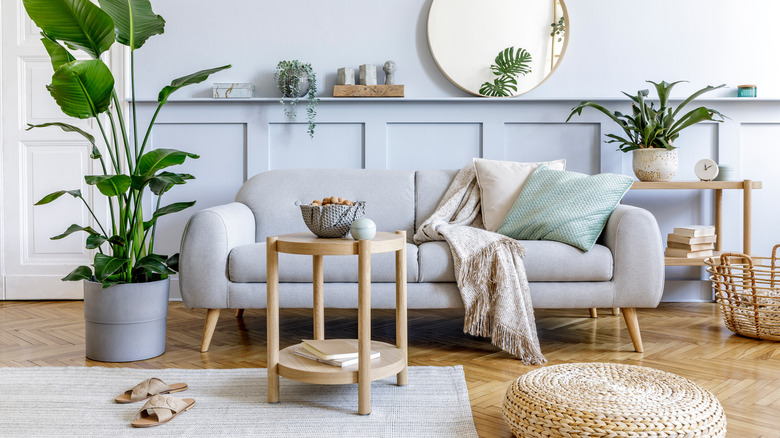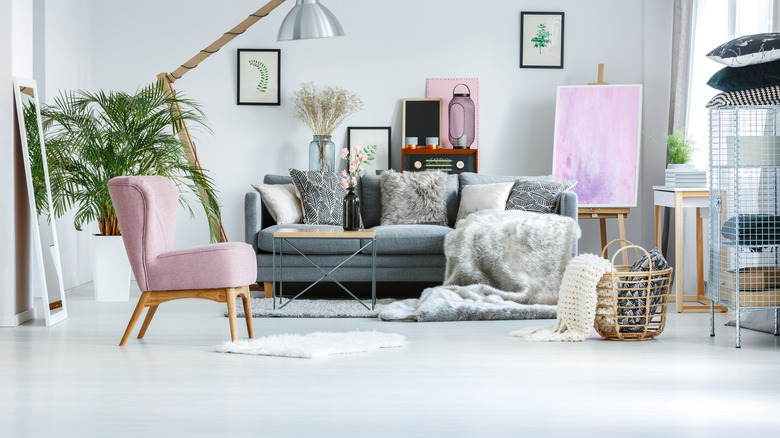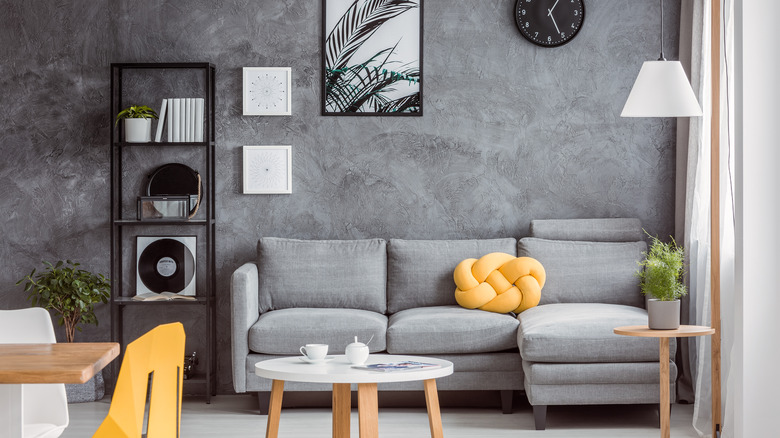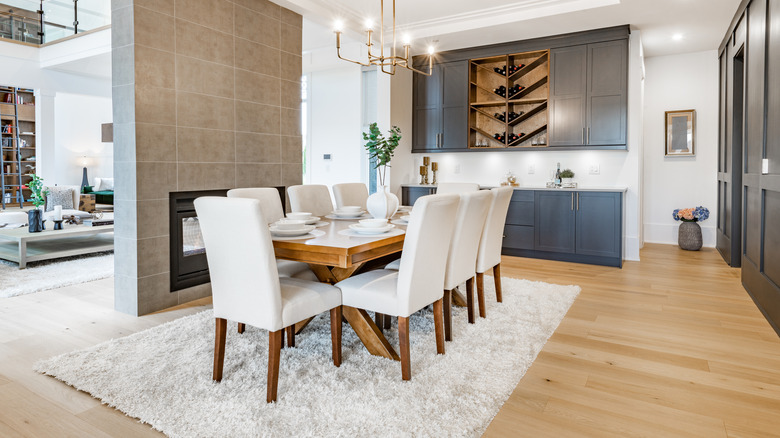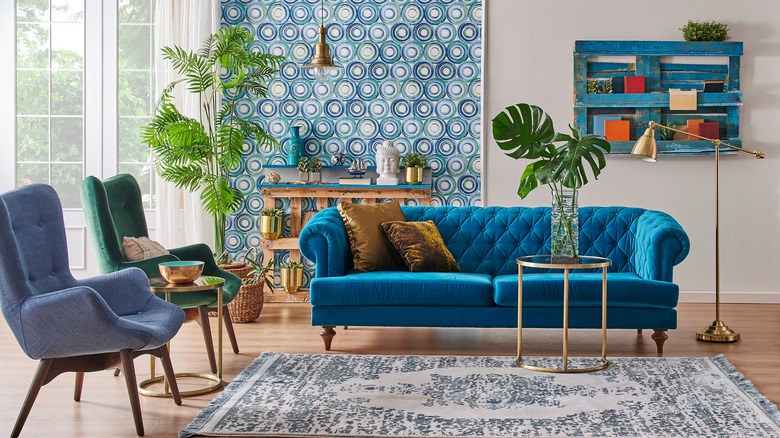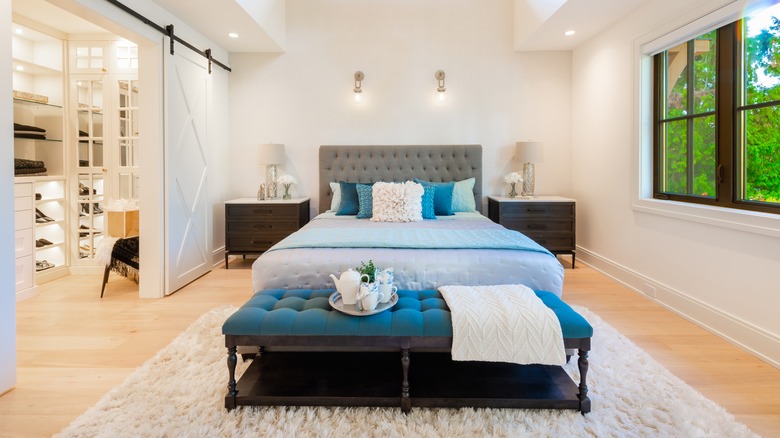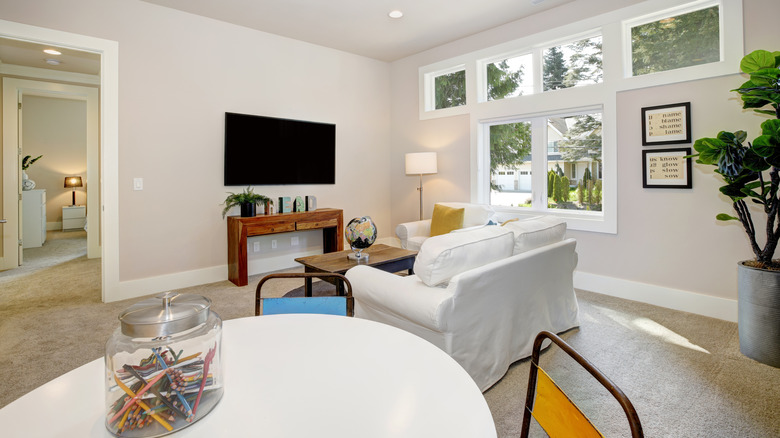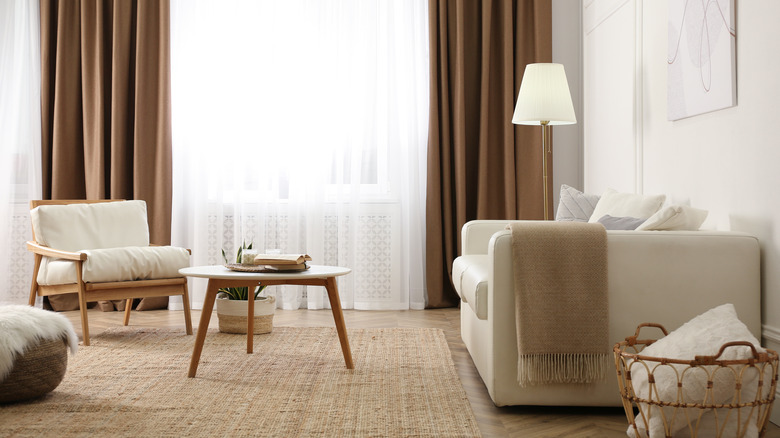The Ultimate Guide To Choosing Upholstery
We may receive a commission on purchases made from links.
While flooring, wall color, lighting, and accessories are all part of interior decor, nothing completes a look like the soft furnishings in the room. Sofas, loveseats, accent chairs, ottomans, fabric styles, and upholstery pieces add color and sweet texture to a room. "My clients ask about the most important pieces to invest in: I believe in upholstery and art," designer Ashley Darryl told House Beautiful. "They help anchor a room."
When decorating your interior with plush fabrics, footstools, and casual napping places to entertain guests, you want materials and designs that can withstand the day-to-day activity in a home. Whether you are choosing upholstery for your sofa or purchasing an upholstered furniture item brand new, these pieces are often the most hardworking design elements in the room. Upholstery pieces are an investment, so try to start small and continue reading for the ultimate guide to help you select a piece that will last for years.
What is upholstery?
Are you wondering what upholstery is, exactly? It is the chairs, the sofa, the cushions, the pillows, and coverings that fill your space. The comfy pieces of furniture where you and your family or guests love to watch movies, share stories, and spill crumbs. Upholstery is a combination of fabric types, coverings, stuffing, hardware, and padding that is typically heavier, thicker, and stiffer than traditional fabric. These upholstered pieces are the support system for your decor.
Not all upholstery is the same, though. While the patterns are obviously different (you can see that), the upholstery construction also differs. Pile and flat are the two methods of weaving fabric for all upholstered pieces, per Yorkshire Fabric Shop. This stitching variation gives upholstery its pattern, feel, and structure. How you tell the difference between the two types is in the texture. A flat weave has none, while a pile weave has texture.
Pick the right color
Color is everything — it sets the mood and makes a space feel cozier, spacious, smaller, and more dramatic. Picking a color for your upholstered piece depends on several factors, including style, color palette, and placement. Placement affects colors directly as light sources can skew tones and color variations, per Color Glo International. Where you put the piece will determine how bold or basic the shade needs to be. Direct light sources will fade the upholstery over time, making lighter fabrics favorable for areas with direct sunlight. They won't show fading as much as darker colors. To prevent fading on dark or light colors, protect the furniture with conditioners and fabric protectors.
Choose an upholstery piece that fits the existing color palette in your interior by matching the tones (warm or cool). There are different shades of every color, which are apparent when off. Have you ever seen two tones of red next to one another? When choosing colors for the upholstery pieces in your home, you may want an up-close moment with the shade you think you like. On-screen color is different from the real thing, and it may be best to order swatches of your favorites for an accurate representation in your home. The color choice can sway the design of an interior.
Decorate with patterns on patterns
How much pattern is too much? Mixing patterns can be daunting, but that's because you think there are rules to follow. The first rule of decorating with patterns is that there are no rules. "I like mixing and matching patterns — I call it happy clashing," interior designer Sophie Ashby told Homes & Gardens. "There are no rules, but much like an art collection where you might have a sculpture, a photograph, a painting and a sketch, I quite like having a floral with a stripe and then maybe an abstract pattern and something more vintage and ethnic." A mix of patterns creates a harmonious blend of movement in an interior.
When adding upholstery pieces with patterns and prints, go all in. More than one patterned upholstery piece is acceptable in the same room. Decorating with patterned plush furniture is a great way to break up solid hues and add dimension to the home.
Pay attention to material
When choosing any upholstery furniture piece, the material choice always matters. The look of it, the color of it, the feel of it. Which material is the best? That's up to you and your interior. The material choices widely differ in terms of longevity and appearance. According to Yorkshire Fabric Shop, upholstered furniture features cotton, silk, wool, synthetic blends, nylon, rayon, crypton, polyester, suede, microfiber, olefin, velvet, and chenille. A list like this can make someone shopping for upholstery a bit flustered but not you.
You already know that upholstery furniture is an investment and good quality material is necessary to withstand daily use. Upholstery-style furniture is comfortable for the home and the owner. You can't go wrong choosing most materials since you can maintain them effortlessly. Accentuate your interiors with a combination of natural and synthetic materials. You can use more than one type to bring together a whole scheme.
Add structure with stitching
The better the stitching is on a piece of furniture, the better it will look up close and from a distance. Plain and simple. The stitching at the edges helps create the form and angles all around a piece of furniture, even if you can't exactly see the thread. So, what does stitching have to do with upholstery? Essentially, everything that affects it visually.
The stitching on the furniture is what you view as its structure, and not all seams are the same. Plain seams, topstitches, and French seams are some stitching methods used to craft furniture, per Icons of Denmark. A topstitch gives a piece of furniture extra durability and accentuates its form, while the other style is a bit more decorative. The type of stitching used on the upholstered furniture will determine its final appearance and overall shape, ultimately influencing whether it fits the interior.
Choose comfortable cushion filling
When you plop on the sofa or snuggle into an accent chair, it should wrap you in a warm embrace. An upholstery chair or sofa should be comfortable to sit on for more than a few minutes. The cushion filling determines the level of comfort you feel. Not enough or too much filling could be uncomfortable while watching a show, scrolling on your phone, or reading a book. Consider the filler material of an upholstery item before purchasing.
Foam is a primary filling option, either memory or poly-wrapped, and requires no fluffing since it retains its shape. "The firmness of a couch's cushion does not reflect durability. But the density of the foam does correlate to the quality and longevity of a product," Joshua Siegal, the owner of BSC Furniture, told The New York Times. While firm, dense, and durable, it's not the only choice. You can consider goose-duck down, batting, polyester, hollow fiber, or polyurethane as filler options for your upholstery furniture. Your interior will likely be filled with several furnishings with multiple cushion fillings, giving you a chance to choose a favorite.
Consider durability
When you purchase furniture, you want it to last, at least long enough for it to see some really great years. Durability and stain resistance without relinquishing style is paramount when shopping for upholstery furniture for your home. As the designer of your own walls, ask yourself this question: How will you and your family be using the upholstery? Sitting is expected, but what about jumping or kneeling? Pick a seat that will outlast your intentions for it.
Furniture durability directly correlates to how long it will last plus the intended usage. According to Yorkshire Fabric Shop, cotton is a prime material for the everyday chair or sofa since it withstands wear and tear for long periods. While a leather seat offers similar durability, it also has a distinct beauty that resists liquids. However, if you don't like either of those options, no problem. Microfiber and olefin withstand kids, pets, and adults with equal tenacity. Pick the upholstery that is durable for your daily life.
Maintenance is key
When shopping for fabric for your upholstery, ensure the material is durable and low-maintenance. Choose a fabric based on who will use it and factor in future wear and tear. Fabrics are rated for wear and tear based on their results on the Martindale Rub Test, per Just Fabrics. Material ranging from 15,000 to 30,000 is desirable for most rooms. 15,000 is best for pieces like dining room chairs, while fabric with a rating of 30,000 is for high-traffic spaces.
The rub test determines the resistance of the fabric. The results give a good idea of the fabric's capability, indicating what it will take for you to keep it in tip-top shape. You can easily maintain durable material with a decent rub score without relying on professional cleanings. Use a homemade solution of white vinegar, warm water, and dish soap to keep it clean. Maintaining the beauty, color, and fabric quality are essential to preserving your upholstered piece of furniture for continual use and future admiration.
What color are the walls?
If you're in the process of painting your walls, the color choice may impact your upholstery selections. The tones that appear in the wall color should complement the fabric selections. To best pair similar items together, pick the paint first. According to The Decorologist, finalizing your paint selection first is wise since it's what a person sees first in a room. Choosing or knowing the wall color of the interior before purchasing an upholstery piece or reupholstering one may make matching it easier.
You will want to coordinate the colors in the fabrics with the color on your walls. Note the undertones in the paint, like blue, lavender, and green, and choose fabrics that highlight the tone. Identifying this hidden pigment in your color choices will tie the unexpected pops of color together. Not all white paint colors are the same, and even neutral colors have undertones. This color concept applies to fabrics, too.
Dress up the dining room
Do you have upholstery furniture in the dining room? If you want a classic and contemporary dining room to impress family and guests, consider adding these unique furnishings. The days of hard, uncomfortable dining room chairs are fading as more people are bringing fabric chairs to the dinner table. The plush fabric is comfortable for daily meals and holiday celebrations. Chairs wrapped in upholstery are stunning and can be appreciated even more when you sit in one.
Choosing to decorate your space with dining room upholstery chairs introduces a certain level of sophistication into the decor. If the room feels neutral, stick to the tone by adding mid-century-inspired chairs from Arhaus. Opting for a neutral palette in this space makes it easy to transition other elements into the aesthetic. For those who don't shy away from bold colors, use this opportunity to add a rich shade of your favorite accent color.
Create contrast in the living room
One of the most used rooms in the house has to be the living room. Everyone gathers in this space for movie nights, TV shows, and just hanging out. Considering its many uses, comfortable furniture that looks nice and lasts a while is essential for this space. While upholstery furniture isn't a new concept for the living room, the style, material combinations, colors, and designs are.
When choosing upholstery pieces for this area, create a juxtaposition between the sofa and any accent chairs or ottomans. In other words, no matchy-matchy. "Playing it too safe with color choices will result in a space that feels bland," designer Amy Carman told Alchemy Fine Home. "Adding contrast to your space ensure every item pops." The blend of solid color and pattern makes the seating choices a statement item rather than just background noise. You want the upholstered pieces of furniture to be different but cohesive, like a solid sofa with a complementary patterned chair.
Enhance cozy vibes in the bedroom
Upholstered decor in the bedroom is a must. Bedroom staples like bed frames, chairs, and benches wrapped in upholstery introduce a luxurious vibe into any bedroom. Begin adding soft elements to the room by focusing on the large pieces like the bed frame or seating arrangements. The large items often capture most of the visual attention and square footage, making them an instant focal point amongst the decor. Utilize the statement piece or the surrounding items to create a cohesive and cozy setup where you can spend time and unwind.
An upholstered headboard and frame is just dreamy and comes in a variety of styles, including velvet and button tufted. If a large item doesn't need replacing in your place, continue building your oasis in the bedroom by adding upholstered accent furniture around the larger pieces. A cream boucle bench by Studio McGee and Target or a pair of accent chairs at the end of the bed can be just as cozy. Decorating with pillow-like and soft textures through upholstery is perfect for creating a comfortable vibe in the bedroom.
Use a slipcover for a brand new look
New furniture items are not always necessary when decorating a home, but you need to be more creative to get the desired look you want with existing furniture. If you cannot replace what is already in your interior, try to update pieces with slipcover upholstery, as seen at IKEA. This decorative hack instantly changes the color, style, pattern, or texture of a sofa or chair and delivers that upholstery look. Other covers are available for barstools, couches, accent chairs, and cushions from various retailers.
The seating will determine what slipcovers will fit. Ensure accurate measurements so that the furnishing is covered. The old piece shouldn't be visible from under the slip. When covering a sofa, consider the cushions, arm, legs, and depth, as different covers will have different dimensions for these variables. Apply similar techniques for other furniture items. Be kind to the environment, your wallet, and your interior by decorating with slipcovers.
Accessorize with curtains and cushions
Upholstery doesn't have to be where you sit or stand. In fact, it could be something that's not even furniture at all. Shift your focus from furniture to accessories for this last upholstery tip. Curtain window panels and cushions are upholstery accessories you can use to decorate your interior for a fresh new look. Most curtain panels and cushions have the same materials as upholstery chairs and sofas, including cotton, silk, and velvet. Traditional curtain and upholstery panels are slightly different in their construction. The materials in an upholstery curtain style may have a longer hang time as the fabric is thicker and heavier with a higher rub score than typical drapery, per Revolution Fabrics.
Whether on the walls or the floor, upholstery has a place in every interior regardless of your style. Upholstery furniture is an interior feature that can soften an aesthetic and add comfort, durability, and maintenance. Find your perfect upholstered match and decorate for inspired interiors.
